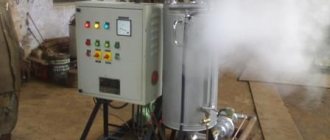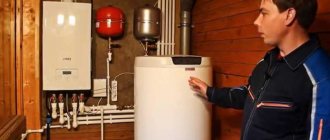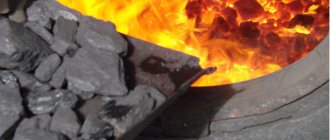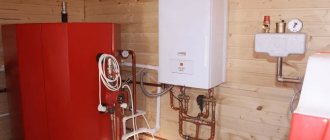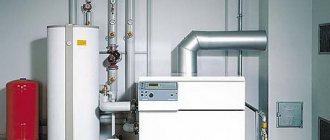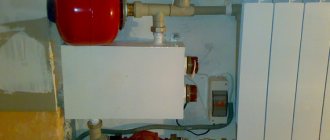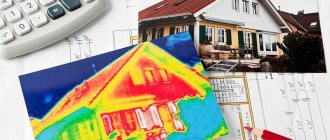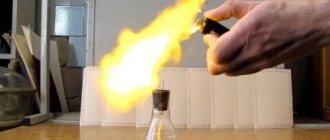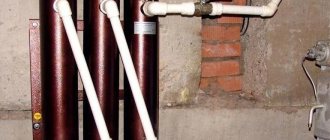Many people associate electric heating of a home with the installation of appropriate water boilers with heating elements, convectors, or laying heated film floors. However, there are many more options. In modern private homes, electrode or ion boilers are installed, in which a pair of primitive electrodes transfer energy to the coolant without any intermediaries.
Ion-type heating boilers were first developed and implemented in the Soviet Union to heat submarine compartments. The installations did not cause additional noise, had compact dimensions, there was no need to design exhaust systems, and they effectively heated sea water, which was used as the main coolant.
The heat carrier, which circulates through the pipes and enters the working tank of the boiler, comes into direct contact with the electric current. Ions charged with different signs begin to move chaotically and collide. Thanks to the resistance formed, the coolant heats up.
- 1 History of appearance and principle of operation
- 2 Characteristics: advantages and disadvantages
- 3 Design and technical characteristics
- 4 Video guide
- 5 Simple DIY ion boiler
- 6 Features of installation of ion boilers
- 7 Manufacturers and average cost
History of appearance and principle of operation
Within just 1 second, each of the electrodes collides with the others up to 50 times, changing its sign. Thanks to the action of alternating current, the liquid does not divide into oxygen and hydrogen, maintaining its structure. An increase in temperature entails an increase in pressure, which forces the coolant to circulate.
To achieve maximum efficiency of the electrode boiler, you will have to constantly monitor the ohmic resistance of the liquid. At classic room temperature (20-25 degrees), it should not exceed 3 thousand Ohms.
Do not pour distilled water into the heating system. It does not contain any salts in the form of impurities, which means you should not expect it to be heated in this way - there will be no environment between the electrodes to form an electrical circuit.
Read additional instructions on how to make your own electrode boiler here
"Galan" Vulcan 36
was one of the first to begin developing such a family of heating devices, using developments in the military space industry and patented engineering solutions. For a quarter of a century, even the first line of devices has not failed and continues to function.
"Galan" Vulcan 36
Model power 36 kW, suitable only for three-phase network. The maximum current for three phases is 27.3 A. The control is mechanical; the boiler is installed only on the floor.
This model “Vulcan” 36 has many advantages, let’s highlight the main ones:
- ease of maintenance and operation.
- safety and reliability - if an electric short circuit occurs, the current supply wires overheat, the set temperature is exceeded, or a coolant leak occurs, the boiler turns off.
- the coolant volume is 600 liters, the volume of the heated room is 1700 cubic meters.
- affordable cost - the average price is 11,000 rubles.
Characteristics: advantages and disadvantages
An ion-type electrode boiler is characterized not only by all the advantages of electric heating equipment, but also by its own characteristics. The extensive list includes the most significant:
- The efficiency of installations tends to the absolute maximum – not less than 95%
- No pollutants or ion radiation harmful to humans are released into the environment
- High power in a housing that is relatively small in size compared to other boilers
- It is possible to install several units at once to increase productivity, or separate installation of an ion-type boiler as an additional or backup heat source
- Low inertia makes it possible to quickly respond to changes in ambient temperature and fully automate the heating process through programmable automation
- There is no need to install a chimney pipe
- The equipment is not harmed by an insufficient amount of coolant inside the working tank
- Voltage surges do not affect heating performance and stability
You can find out how to choose an electric boiler for heating here
Of course, ion boilers have numerous and very significant advantages. If you do not take into account the negative aspects that arise more often during the operation of the equipment, all benefits are lost.
Among the negative aspects it is worth noting:
- To operate ion heating equipment, you cannot use DC power sources, which will cause electrolysis of the liquid
- It is necessary to constantly monitor the electrical conductivity of the liquid and take measures to regulate it
- It is necessary to ensure reliable grounding. If it breaks down, the risk of being shocked increases significantly
- It is prohibited to use heated water in a single-circuit system for other needs.
- It is very difficult to organize efficient heating with natural circulation; installation of a pump is mandatory
- The temperature of the liquid should not exceed 75 degrees, otherwise the consumption of electrical energy will increase sharply
- Electrodes wear out quickly and need to be replaced every 2-4 years
- Repair and commissioning work cannot be carried out without the involvement of an experienced technician.
Read about other methods of electric heating at home here
The best manufacturers
Due to their advantages, ion boilers remain very popular sources of heat supply on the Russian market.
They are produced by a number of domestic factories, and there are also models from Western manufacturers.
General overview of the most popular brands:
- "Galan", a boiler unit from a Moscow company. The company produces several basic models on a 220 V network: "Ochag", "Turbo" and "Geyser", and on a 380 V network - "Vulcan". For the devices you will need to buy a main control unit "Navigator", a circuit breaker "ABB", a thermostat "BeeRT", which controls the performance of the circulation electric pump.
- Electrode ion boilers Beryl, a Russian manufacturer, are available in 2 standard sizes for a 220/380 V network and, accordingly, with a power of 9/33 kW. It has a top-mounted power supply unit, which simplifies installation and maintenance. It is necessary to additionally purchase a “Euro” CSU unit, which allows for stepwise control of the coolant heating power every 200 W.
- Electrode boilers of the EOU brand of a domestic manufacturer, with a power range from 2 to 120 kW, in a 220/380 V network.
- "Forsazh" of the Ukrainian manufacturer are equipped with a special protective casing that increases safe operation and has a designer appearance. It is presented in 5 modifications for a 220 V network, with a power from 3.0 to 20 kW, which are equipped with an ECRT control unit.
- STAFOR, a Latvian manufacturer, complies with EU requirements. The design has a number of innovative solutions, including the use of a “Faraday cage” with distribution of safety and working zero. Together with it, it is possible to buy a branded coolant and a specialized additive STATERM POWER, which allows timely adjustments to the chemical composition of the electrolyte to regulate the efficiency of the boiler.
Device and technical characteristics
The design of the ion boiler, at first glance, is complex, but it is simple and not forced. Externally, it is a seamless steel pipe, which is covered with a polyamide electrical insulating layer. Manufacturers have tried to protect people as much as possible from electric shock and leaks of expensive energy.
In addition to the tubular body, the electrode boiler contains:
- The working electrode, which is made of special alloys and is held in place by protected polyamide nuts (in models operating from a 3-phase network, three electrodes are provided at once)
- Coolant inlet and outlet pipes
- Ground terminals
- Terminals supplying power to the chassis
- Rubber insulating pads
The shape of the outer body of ion heating boilers is cylindrical. Most common household models meet the following characteristics:
- Length – up to 60 cm
- Diameter – up to 32 cm
- Weight - about 10-12 kg
- Equipment power – from 2 to 50 kW
For domestic needs, compact single-phase models with a power of no more than 6 kW are used. There are enough of them to fully provide heat to a cottage with an area of 80-150 sq. m. For large industrial areas, 3-phase equipment is used. A 50 kW installation is capable of heating a room up to 1600 sq. m.
However, the electrode boiler works most efficiently in conjunction with control automation, which includes the following elements:
- Starter block
- Surge protection
- Controller
Additionally, GSM control modules can be installed for remote activation or deactivation. Low inertia allows you to quickly respond to temperature fluctuations in the environment.
Due attention should be paid to the quality and temperature of the coolant. The optimal liquid in a heating system with an ion boiler is considered to be heated to 75 degrees. In this case, power consumption will correspond to that specified in the documents. Otherwise, two situations are possible:
- Temperature below 75 degrees - electricity consumption decreases along with the efficiency of the installation
- Temperature above 75 degrees - electricity consumption will increase, however, the already high efficiency indicators will remain at the same level
Electrode heating equipment market
The most common electrode boiler units in Russia are the following brands:
— "GALAN" (Russia);
— "EOU" (SPD-FO O.A. Goncharenko, Ukraine);
— "STAFOR EKO" (Latvia).
Manufacturers provide up to two years of warranty on heating units subject to proper operation. The service life of the boiler itself is more than 10 years with regular replacement of the current electrodes every 3 years.
The approximate cost of a 2 kW heating unit is 9.5–
10 thousand rubles, including the necessary control and automation unit
-
6.5
-
7 thousand rubles.
Simple DIY ion boiler
Having become familiar with the features and principle by which ion heating boilers operate, it is time to ask the question: how to assemble such equipment with your own hands? First you need to prepare the tools and materials:
- Steel pipe with a diameter of 5-10 cm
- Ground and neutral terminals
- Electrodes
- Wires
- Metal tee and coupling
- Persistence and desire
Before you start putting everything together, there are three very important safety rules to remember:
- Only the phase is supplied to the electrode
- Only the neutral wire is supplied to the housing
- Reliable grounding must be provided
To assemble an ion electrode boiler, just follow the following instructions:
- First, a pipe 25-30 cm long is prepared, which will act as a body
- Surfaces must be smooth and free of corrosion, nicks at the ends must be cleaned
- On the one hand, electrodes are installed using a tee
- A tee is also necessary to organize the outlet and inlet of the coolant
- On the second side they make a connection to the heating main
- Install an insulating gasket between the electrode and the tee (heat-resistant plastic is suitable)
- To achieve a tight seal, the threaded connections must be precisely adjusted to each other.
- To secure the zero terminal and grounding, 1-2 bolts are welded to the body
Having put everything together, you can embed the boiler into the heating system. Such homemade equipment is unlikely to be able to heat a private home, but for small utility areas or a garage it will be an ideal solution. You can cover the installation with a decorative casing, while trying not to restrict free access to it.
Things to remember
When planning to install an electrode boiler, remember a few important points to ensure that your heating system is durable, safe and highly efficient:
1. Do not neglect the requirements for installation and connection of the boiler unit; take responsibility for the safety and grounding of electrical equipment.
2. If the heating circuit is filled with antifreeze, ensure the tightness and strength of the detachable connections due to its high fluidity. 3. Cover the supply and return pipelines with effective thermal insulation for optimal operation of the boiler unit. 4. The long service life of the heating circuit significantly reduces the efficiency and economy of the ion boiler installed to replace outdated equipment. When installing an electrode boiler, carry out a major overhaul of the existing heat supply system with the obligatory replacement of radiators with modern models of devices; 5. With a branched heat supply scheme, for example in multi-storey buildings, an effective solution would be to install several units on each floor or in each individual building. It will be somewhat more expensive, but more reliable in terms of operation. 6. Heated floors cannot be installed in heating systems with ion boiler units, since the maximum possible coolant temperature for it (45°C) will not allow the boiler to operate in optimal operating mode.
Features of installation of ion boilers
A prerequisite for installing ion heating boilers is the presence of a safety valve, pressure gauge and automatic air vent. The equipment must be placed in a vertical position (horizontal or at an angle are not allowed). At the same time, about 1.5 m of supply pipes are not galvanized steel.
The zero terminal is usually located at the bottom of the boiler. A grounding wire with a resistance of up to 4 ohms and a cross-section of over 4 mm is connected to it. You should not rely solely on RAM - it cannot help with current leakage. The resistance must also comply with the rules of the PUE.
If the heating system is completely new, there is no need to prepare the pipes - they must be clean inside. When the boiler crashes into an already operating main, it is necessary to flush it with inhibitors. The markets offer a wide range of products for removing deposits, salts and scale. However, each manufacturer of electrode boilers indicates those that it considers best for its equipment. Their opinion should be followed. By neglecting flushing, it will not be possible to establish the exact ohmic resistance.
It is very important to select heating radiators for the ion boiler. Models with a large internal volume are not suitable, since 1 kW of power will require more than 10 liters of coolant. The boiler will constantly work, wasting some of the electricity in vain. The ideal ratio of boiler power to the total volume of the heating system is 8 liters per 1 kW.
If we talk about materials, it is better to install modern aluminum and bimetallic radiators with minimal inertia. When choosing aluminum models, preference is given to primary type material (not remelted). Compared to the secondary one, it contains fewer impurities, reducing the ohmic resistance.
Cast iron radiators are the least compatible with an ion boiler, since they are the most susceptible to contamination. If it is not possible to replace them, experts recommend observing several important conditions:
- The documents must indicate compliance with the European standard
- Installation of coarse filters and sludge traps is required
- Once again, the total volume of coolant is produced and equipment suitable in terms of power is selected
RusNIT 208M
, Ryazan. Can be used as the main or backup heat source in a house or domestic premises with an area of up to 80 sq.m. Power 8000 W.
RusNIT 208M
Specifications:
- three-stage power adjustment - 30%, 60% or 100%;
- the heat exchanger and heating element are made of stainless steel;
- antifreeze or distilled water can be used as a coolant in the system;
- the presence of a thermal switch that prevents heating of the coolant above 90°C;
- can be connected to a circulation pump;
- Manufacturer's warranty – 2 years.
Among the disadvantages, we note the manual selection of power, difficulties during connection, requiring certain skills.
The cost of the unit is from 15,000 rubles.
Difficulties in operation
During use, the consumer may encounter some problems characteristic of electrode heaters:
- The quality of the coolant plays an important role. The service life of the product and reliability of operation depend on this. The use of tap fluid can lead to increased corrosion of metal pipes and radiators and a decrease in efficiency. Manufacturers recommend that owners of electrode boilers use ready-made compositions that have the necessary physical and chemical characteristics. The liquid changes its properties over time, so after 3-4 years the system needs to be filled with fresh coolant.
- It is necessary to pay attention to ensuring the electrical safety of the unit. The body of the device is connected to the neutral cable, the phase is connected to the electrodes. During installation, grounding must be provided. Electric boilers create a large load on the network, so before installing the heating device you should make sure that the wiring is reliable throughout the room.
- Under the constant influence of current, the processes of electrocorrosion of steel and cast iron are accelerated, which reduces the service life of the system several times. Aluminum or bimetallic communications and radiators should be used with electrode units. To provide heat to a cottage or home, you need to make sure that the elements of the heating system are made of recommended materials.
Coolant
Electrode boilers are sensitive to the composition of the coolant. In accordance with the requirements of the manufacturers, only distilled water should be used, to which table salt is added, approximately 80-100 grams for every 100 liters. The difficulty lies in the fact that the final density and conductivity of the solution must be in strict accordance with the manufacturer's requirements. It is impossible to determine the exact amount of salt, and it can give different results depending on its composition. The final preparation of the solution is carried out locally, based on the actual current values in the electronic boiler. The instructions for the device provide a table of the required values depending on the boiler power, coolant volume, etc. By adding distilled water or salt, the coolant resistance is brought to ideal.
Only compounds provided by the boiler manufacturer are used as antifreeze. When they are used, the proportion of salt in the solution also changes.
There is a mandatory requirement before using an electronic boiler in an existing heating system in parallel with another boiler. The entire system is washed, cleaned of scale and salt deposits, which can subsequently change the conductivity of the coolant.
Heating with electric boiler
Most often, property owners prefer an electric water boiler for heating a private home. The function of coolant in autonomous systems can also be performed by other liquids, for example, antifreeze. These devices are affordable and their installation is simple.
According to the heating method, electric boilers are:
- ten;
- electrode;
- induction.
A heating element water heater is a traditional device in which the liquid is heated by a heating element that is powered by electricity. After it transfers heat to the coolant, it circulates through the system and distributes energy to radiators located in the rooms.
This boiler is easy to install. It is equipped with a thermostat designed to maintain the desired temperature. The power consumption is adjusted by turning off a certain number of heating elements.
Among the disadvantages of such boilers, one should note the formation of scale on the heating elements, which usually leads to breakdown of the unit, especially when the water is hard. It is necessary to use special means against lime deposits.
Instead of a heating element, an electrode electric boiler has an electrode that acts on water ions, resulting in the release of thermal energy. This electric water heater is safe because it is immune to coolant leakage. If there is no water, then the device stops working.
This method of heating the coolant does not lead to the appearance of limescale, but the electrodes begin to deteriorate over time and need to be replaced. Non-freezing liquid cannot be used in such boilers - only electric water heating of a private house is allowed. In this case, water must have a specific resistance of a certain value.
An electric induction boiler consists of a radiator and a pipeline through which a coolant liquid circulates. It does not have a heating element. The emitter creates an electromagnetic field that interacts with the metal. Electricity creates vortex flows, which in turn release heat to the liquid.
The induction unit is easy to install and maintain, it has no wearing parts, it is effective for heating large rooms, and practically no scale accumulates in it. The coolant can be not only water, but also antifreeze.
It is not difficult to make such a boiler with your own hands, and it will cost much less than one made in a factory. Its significant disadvantage is the large parameters of the device and the high price when compared with heating element and electrode units.
In addition, if the integrity of the circuit is mechanically damaged, the induction boiler will not be able to operate due to dangerous temperature increases. To prevent damage to the device, it should be equipped with a sensor that will turn it off if there is no water in it.
All methods of heating suburban real estate with electric heating devices have many advantages: safety, no need to stockpile fuel, noiselessness, environmental friendliness, simple operation. But currently electricity is expensive and therefore many owners do not use this heating option.

